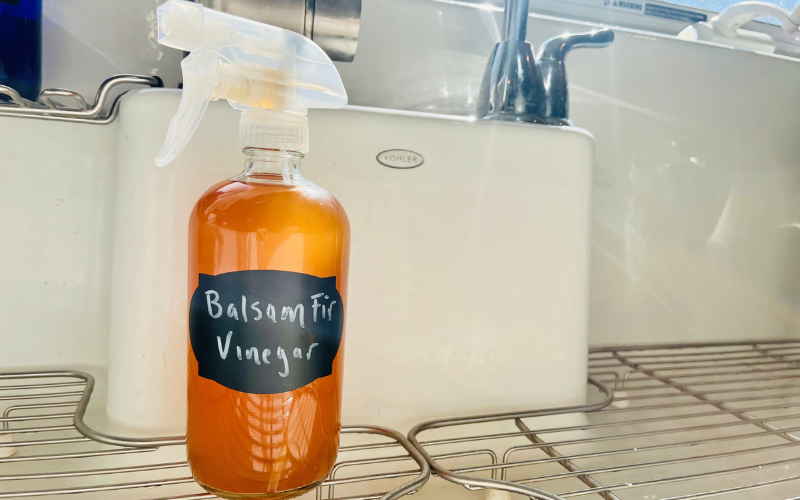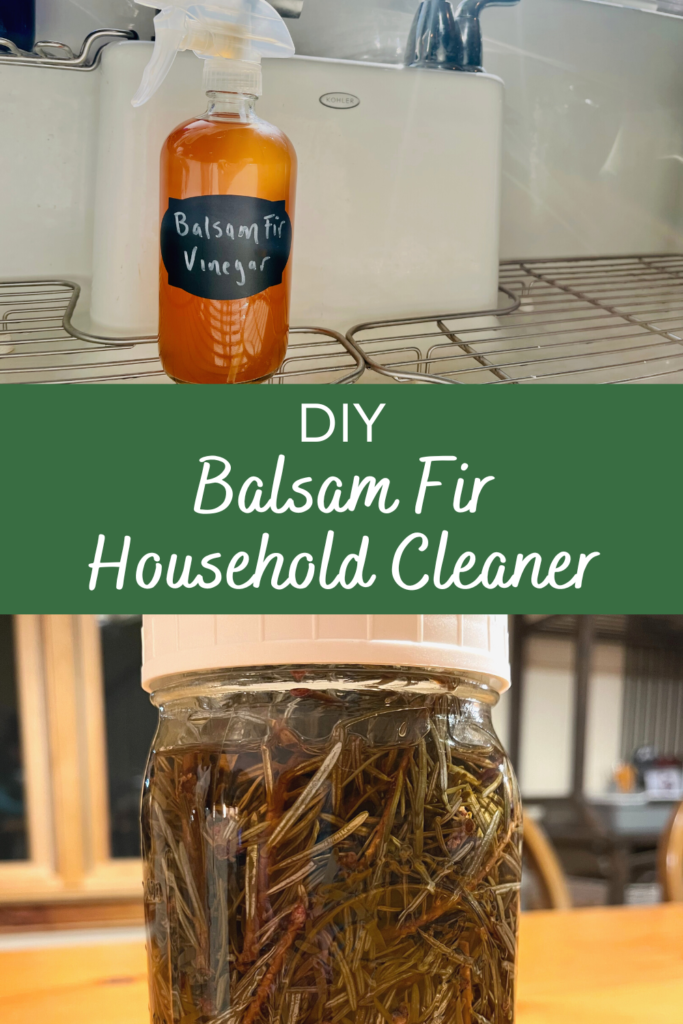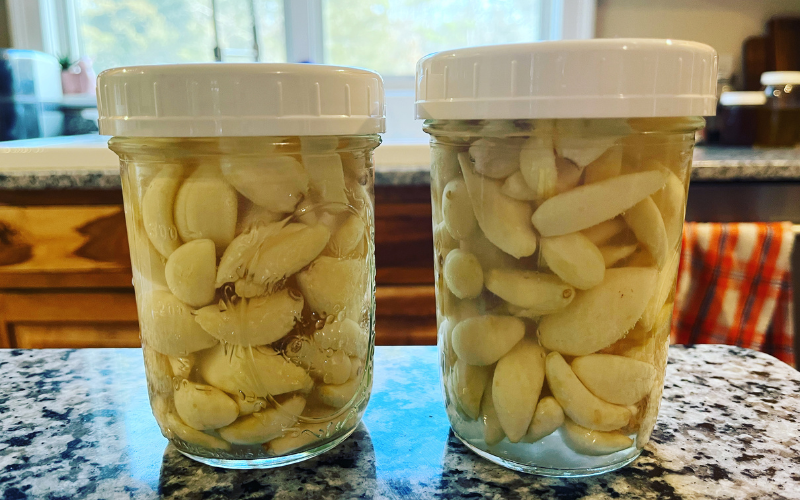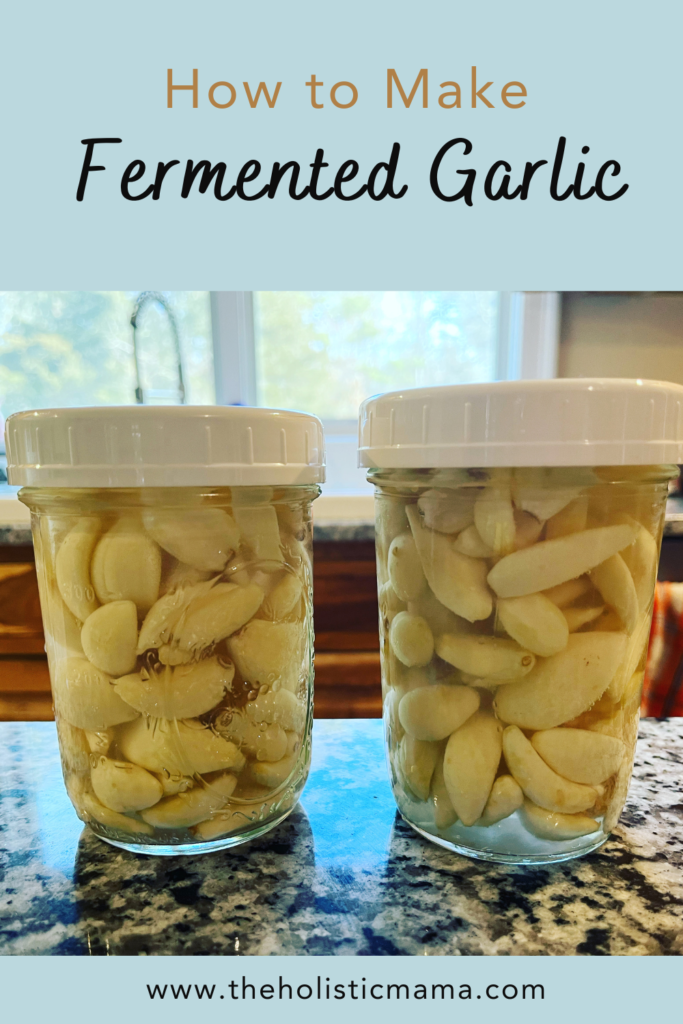-
Non-Toxic Household Cleaning Spray
Category: Herbalism
Making a non-toxic household cleaning spray is easy and you probably already have what you need to make it at home. Many of the store bought cleaners contain unhealthy ingredients (even ones that look natural) so making your own is a good alternative. Strong chemical cleaning products can cause poor air quality inside your home so it's important to choose non-toxic cleaning products.
Creating a cleaning vinegar is the same process as making an herbal tincture except use vinegar instead of alcohol. First choose an herb which will be the scent of your cleaning spray. All of these herbs work well:
- Pine needles
- Lemon peels
- Orange peels
- Grapefruit peels
- Lavender flowers
- Eucalyptus leaves
- Peppermint leaves
- Cloves
- Cinnamon sticks
Next, gather the equipment and ingredients needed to make this recipe listed below.

Non-Toxic Household Cleaning Spray How to Make Non-Toxic Household Cleaning Spray
You will need:
- Mason jar with a plastic lid
- Glass or plastic spray bottle with a label
- White vinegar
- Plant matter of your choice
Instructions:
- Pack a mason jar with your plant matter.
- Pour white vinegar over the plant matter until you have filled the jar and close the lid.
- Let the jar sit for 3-8 weeks.
- After the time is up, strain out the vinegar and pour into a spray bottle. You can use this herb press to get out every last drop (but it's not necessary). Be sure to label your bottle.
- Optional: add a drop of liquid castile soap for extra cleaning strength.
Thank you for reading this post, don't forget to subscribe to stay in the loop. If you are looking for some of the healthy tools and resources mentioned in my articles, take a look at my healthy shopping guide.
Some of our links are affiliate links, which means if you click and buy, I earn a small commission. The price is the same for you, though. Thank you!
You might also like these posts…
-
Fermented Garlic Recipe
Category: Fermenting
- 5-8 garlic bulbs peeled (roughly)
- 2 cups filtered water
- ½ teaspoon sea salt & ⅛ teaspoon Cutting Edge Cultures OR 1 teaspoon sea salt
- 1 pint mason jar with a plastic lid or airlock lid
In this fermented garlic recipe, start with a clean pint jar. Fill the jar with peeled garlic cloves leaving 1 inch space to the top of the jar.
In a glass measuring cup mix together the salt and culture (if using). Once everything is combined and dissolved, pour the salt brine over the garlic. Close the lid to the jar loosely to allow air to escape OR use an air-lock top. Air lock tops are very handy to have for small fermenting recipes like this one.
Let the jar sit on a counter and open the jar daily to let out some air (unless you are using an airlock top you won't need to open the jar at all).
In 3-4 days you will see your fermented garlic recipe will be ready. The liquid will be getting bubbly and cloudy. When you decide that it is done, screw the lid on firmly and place the jar in the fridge to store.

How to Use Fermented Garlic
This Fermented garlic recipe will make the garlic cloves last longer and add even more health benefits to the garlic. Once the garlic is fermented, it has probiotics in it and when eaten raw (or used raw in recipes) you will receive all that probiotic goodness. Use your fermented garlic in recipes as you would a regular clove of garlic.
Recipe ideas to use your fermented garlic include:
- Guacamole
- Hummus
- Sour Cream Dip for Veggies
- Honey Mustard Salad Dressing
- Balsamic Vinaigrette Salad Dressing
It's perfect for uncooked recipes like salad dressings and dips. Fermented garlic can be used in cooked recipes like soup or vegetable sautés, but heating it will kill the probiotics. It is still a great way to preserve the garlic and make it last longer without going moldy so it's still worth it to use in cooked recipes.
Thank you for reading this post, don't forget to subscribe to stay in the loop. If you are looking for some of the healthy tools and resources mentioned in my articles, take a look at my healthy shopping guide.
Some of our links are affiliate links, which means if you click and buy, I earn a small commission. The price is the same for you, though. Thank you!
You might also like these posts…
-
How to Make an Herbal Tincture
Category: Herbalism
It is a very simple process to learn how to make an herbal tincture at home. A tincture is an extract of a plant material dissolved in a solvent. Tinctures are made by soaking an herb in alcohol (vodka or rum), vegetable glycerin, or vinegar. Soaking the herbs encourages the active plant constituents to dissolve, giving the tincture a strong medicinal action in comparison to an infusion or decoction. They also last longer because the solvent is shelf stable for up to two years.
Standard Ratio is 1:5 (1 part herb to 5 part solvent)
- 200g dried or 300g fresh herb chopped into small pieces
- 1 quart solvent – alcohol (80 proof vodka is ideal), glycerin (3 part glycerin 1 part distilled water), or vinegar
Standard Adult Dosage: 1 tsp 2-3 times per day diluted in water or fruit juice
Storage: Store in a sterilized dark glass bottle in a cool dark place for up to 2 years.

How to Make an Herbal Tincture Step by Step
- Place herbs in a large, clean glass jar and pour on the solvent ensuring that the herb is covered.
- Close and label your jar with the name of the herb, solvent, and the date.
- Shake the jar for 1-2 minutes.
- Store in a cool dark place for at least 10-14 days (or longer), shaking the jar every 1-2 days.
- After 14 days you are ready to strain out the herbs. Pour the jar through a mesh strainer or cheesecloth. (There are some new fancy tools for this I have found like this herb press that helps make it less messy and extracts every last drop).
- Squeeze out the herb to get all remaining liquid.
- Discard or compost your herbs.
- Pour your finished tincture into a clean dark class bottle using a funnel.
- Close and label your jar with the name and date of your tincture.
Some of the tinctures in our store include Elderberry Glycerite and Congestion Glycerite which were made with this exact method.
Should Your Use Fresh or Dried Herbs?
The answer to this question depends on the type of herb but most of the time fresh plant matter is ideal when making an herbal tincture. Always use 100 proof vodka when using fresh herbs. You can use 80 proof when using dried herbs due to the lack of water content.
Thank you for reading this post, don't forget to subscribe to stay in the loop. If you are looking for some of the healthy tools and resources mentioned in my articles, take a look at my healthy shopping guide.
Some of our links are affiliate links, which means if you click and buy, I earn a small commission. The price is the same for you, though. Thank you!
You might also like these posts…
Holistic Mama Blog

